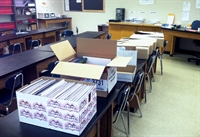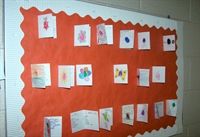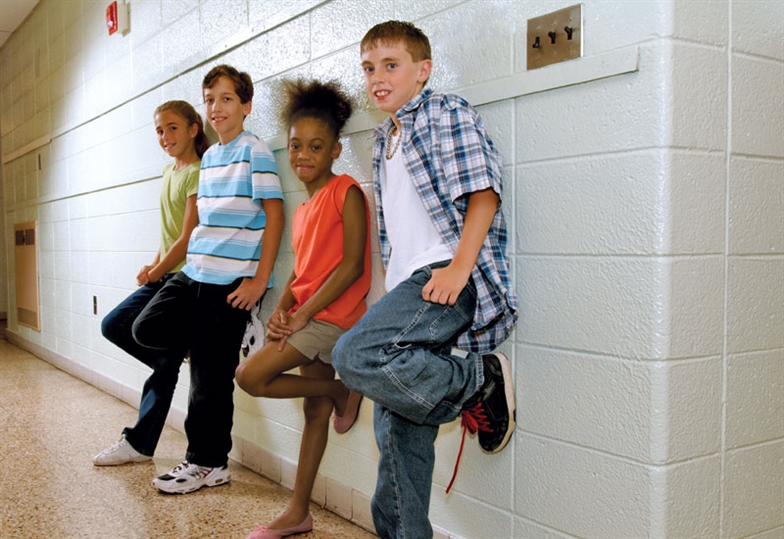Middle grades students are small, medium, and big bundles of morphing cells. Just walk through the halls of a middle school during class changes and you will realize how unsure they can be about their physical presence.
Should I walk or run? If I walk, should I walk forward or backward? Wait, I forgot something, I’ll turn around and run.
They also struggle with their social presence. Middle school takes them from a self-contained elementary classroom with 25 other students forced by proximity to be their friends into a “team” of 100 or more students, many of whom they have never met.
Add to this the stress of a locker.
Do I turn left first or right? How many times? Oh no, I can’t remember my combination. Mrs. D’Amore, my locker won’t open.
These students need a smooth transition from the small, predictable elementary environment where they have a single grade level teacher and single class of their peers to the bigger world that is middle school.
Transitioning from the self-contained unit structure of most elementary schools, which allows students and teachers to make quick, secure connections, to the middle school, which is centered on teams of teachers and students, sometimes means that personal connections in school take a backseat.
Yet, research has shown that the more teachers foster relationships with their students and focus on their social and emotional needs, the more academic performance, motivation, and attendance improve.
First Things First

Community service is an important part of an effective advisory program. LaMuth Middle School students gathered 50 paper boxes of school supplies for a school in Brooklyn flooded by Hurricane Sandy.
The affective domain must be attended to before we turn attention to the cognitive domain. By providing an effective advisory program, schools can help improve interpersonal relationships and promote cooperation in achieving student and school goals.
Patrick Akos, professor of education at the University of North Carolina, contends in a 2006 issue of RMLE Online that middle schools that use advisory classes to promote positive experiences for students in transition will establish those interpersonal relationships necessary to improve overall school success. D. J. Foote, in his 2007 doctoral dissertation for the University of California says that although advisory programs can vary broadly from school to school, the teacher-advisor relationship is still a source of support no matter how the program has been implemented.
Advisory programs that help students feel cared for by providing a personal contact for problem solving are an effective strategy to help students make the transition into the middle school environment.
Launching Advisory
Now, I am probably the least touchy-feely teacher in my building. I keep my emotions strictly under control. Don’t get me wrong, I enjoy the kids immensely. Their actions and comments could fill books worthy of an amusing and pleasurable read. However, I never was comfortable taking too much time away from the lesson plans to relax and just be with the kids. Extraneous conversations did not happen often in my tightly run classroom.
I knew this was a problem that I needed to address and chose it as the topic for a master’s action research thesis. It is for these reasons that I co-wrote and tested an advisory program that focuses on making connections with students. The rationale is that the peer-to-self, peer-to-peer, peer-to-adult advocate, peer-to-school, and peer-to-community connections needed to be made early in the school year in order to enhance academic performance.
Our advisory program includes activities that take approximately one to two hours a week for the first semester, gradually moving the focus from social/emotional awareness to academics. The advisory program involves a series of seamless steps.
- Advisors and advisees become acquainted and begin building relationships. Prior to meeting the students, advisors solicit parent involvement by sending an introduction letter to each family within their advisory group. The letter explains the structure and purpose of the advisory program and provides contact information for their child’s advisor.The letter asks parents to reply with information they wish to share about their child. The goal is to make a connection between the advisors and parents as early as possible, as this is an integral part of an effective advisory program. It is a means to introduce advisors, advisees, and parents.
- We implement activities to build a sense of self and to improve self-esteem. For example, the students and advisor take an inventory of experiences and skills that ask “have you ever” type questions; for example, “Have you ever waterskied or written a poem?” We share these lists and find commonalities.Students say this activity helps them recognize that they are different but also fit in. They uncover unique qualities of which they are proud and develop relationships based on similar experiences.
- The advisory program transitions from activities focused on self to activities focused on building relationships and communication skills. After reviewing a list of listening tips, advisory classes practice these skills in a variety of activities.For example, an obstacle course is set up and students are randomly paired to guide each other through the course blindfolded. The obstacles are pieces of paper on the floor that may say “Tease the new student,” “Exclude someone from the lunch group,” or “Don’t study for a test.” One student reads the obstacle aloud then guides his partner around it. Listening skills, communication techniques, group dynamics, and friendships are developed during this phase.
- We enhance a sense of community among students. First, students analyze and evaluate their advisory class, team, and then school. Students assess what is working well and what could be improved. Next, students create a motto for advisory. Mottos are created, shared, and voted on.Students work together to plan and implement an advisory, team, or school celebration. The last part of this phase is focused on community service. The students choose a local charity and collect donations to support that charity.
The Pay Off

Students express their individuality and unique traits through thumbprint drawings and name acrostics.
The results of our advisory program include higher overall GPAs, increased attendance rates, and fewer behavior referrals. At first, several teachers were worried that getting close to the students through advisory might mean uncovering information about which the teachers might feel uncomfortable. We reminded them that counselors are available to give the kids help for what’s bothering them earlier rather than later.
In the two years since we implemented the program, my students have commented that they feel like our advisory class is a little family, and they wish we could do more activities together. I feel the same way.
Being an advisor was an awesome experience. I have never felt more connected to my students. I will continue to implement, revise, share, and build our program. I know it is an important component to middle school success. This I believe.
Ellen D’Amore is a seventh grade science and math teacher at LaMuth Middle School in Painesville, Ohio. She is the co-author, with Erin Clayton Tobul, of an advisory program that earned the Ohio Middle Level Association Advisor/Advisee Component Award in 2013. ellen.damore@riversideschools.net
Published in AMLE Magazine, August 2013.
